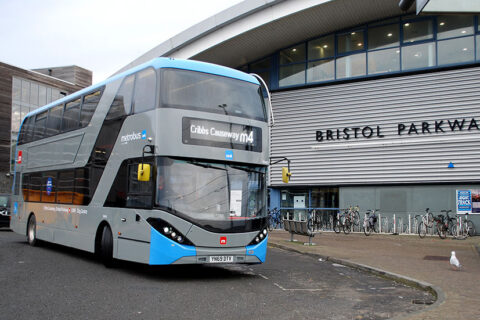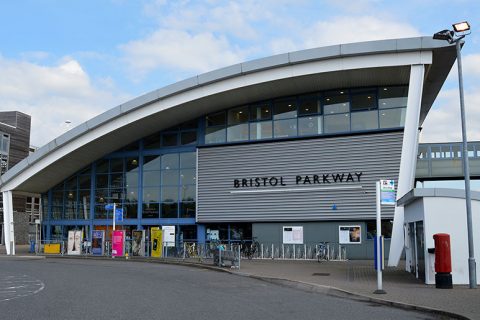
Plans to transform Bristol Parkway Station have been approved by South Gloucestershire Council’s Cabinet, despite some elements of the proposals – such as reducing the number of parking spaces – receiving less than enthusiastic support in a public consultation.
The new vision for the site aims to create a modern station that acts as a gateway to the region but is also better connected with the neighbouring communities of Stoke Gifford, Harry Stoke and Bradley Stoke.
The vision, presented in a strategic masterplan, will aim to improve walking, wheeling (wheelchairs and mobility scooters) and cycling routes to and from the station, improve connections to local bus services, make better use of the land available, as well as provide new retail and leisure facilities, and community spaces. Housing and employment space is also being considered for the site.
It will also look to address long-standing issues at the Brierly Furlong underpass by creating a new parallel subway for walking and cycling.
The masterplan, which has been updated following six weeks of public engagement in July & August 2022, aims to transform Parkway into a ‘living station’ – a concept that re-thinks what a train station is. A place that serves local people, communities, businesses and a place where people want to spend time.

The masterplan proposes the station is developed into four unique areas that will be connected by a new street running through the site. These areas include:
- A new community park called St Michael’s Place
- A station building and public space called Station Square
- A new nature reserve and green space called Stoke Gifford Park
- A new employment area called The Brickworks
The new vision for the station will also help in the council’s response to the climate and nature emergency through the development of green spaces, supporting biodiversity and encouraging sustainable travel.
Engagement report
An engagement report produced following the public consultation found that 36 percent of the 245 respondents “support the overall vision for the station and surrounds as presented in the draft masterplan”, with 33 percent saying they were “somewhat supportive’, 9 percent ‘somewhat against’, 13 percent ‘strongly against’ and 9 percent ‘not sure’.
A couple of the more detailed questions posed by the consultation attracted less favourable responses, including:
- ‘High density developments, minimising land use’: Strongly or somewhat supported by only 49 percent
- ‘Reducing the overall number of car parking spaces at the station over time’: Strongly or somewhat supported by only 38 percent, with 50 percent strongly or somewhat against

Partnership working
South Gloucestershire Council has worked in partnership with Network Rail, GWR and the West of England Combined Authority on the new masterplan for the station.
South Gloucestershire Council’s Cabinet member for transport, Cllr Steve Reade, said:
“This new masterplan is an ambitious vision to transform Bristol Parkway into a major new destination and for it to become a fitting gateway for the region and South Gloucestershire.”
“This masterplan reimagines Bristol Parkway as a destination complete with a new station, places where people can work, meet friends and family, as well as providing new parks where residents can enjoy the outdoors.”
“I’m pleased to see that the masterplan is leading from the front in respect of climate change, moving away from car-based travel and encouraging public transport and active travel, which will help to reduce air pollution.”
“Bristol Parkway Station has celebrated its 50th anniversary this year and this masterplan and its future vision is a great way to mark such a milestone.”
Dan Okey, Head of regional development at Great Western Railway (GWR), said:
“At GWR we are dedicated to the communities we serve and are pleased to have worked with South Gloucestershire Council, Network Rail and the West of England Combined Authority to look at the future of Bristol Parkway station.”
“The plan rightly sets an ambitious vision for the station and surrounding development. Improving interchange, station capacity and enhancing customer facilities are central to the vision.”
“We look forward to working with our partners to turn this into reality, as we work to revalue rail in the hearts and minds of the travelling public.”
Malcolm Parsons, Network Rail industry programme director, said:
“The Bristol Parkway masterplan, which we’ve worked on with South Gloucestershire Council, GWR and the West of England Combined Authority, is an ambitious reimagining of the station as an improved gateway to the north Bristol area and beyond.”
“The plan focuses on enhanced connectivity with the surrounding communities and puts accessibility at the heart of Bristol Parkway with improved facilities for those who use wheelchairs and other mobility aids.”
“Alongside these benefits, the plan seeks to encourage sustainable travel and will provide more green spaces to enhance biodiversity.”
“We’ll continue to work with our partners and the local community on the redevelopment of Bristol Parkway to ensure that it suits the needs of passengers, the environment and the communities it serves.”
Timescale & funding
The masterplan sets out a future vision and blueprint for change at Bristol Parkway “over the next 10 years and beyond” or, according to another section of the document, how it “could look and feel over the next 20 years”.
The changes would not be delivered in one phase. It is likely to take “a number of years” for the scheme to be realised in full as different parts of the site are created or changed in line with the availability of various funding streams.
Possible funding sources include public sector grants or loans, value capture mechanisms (from increased land values around the station), station-related commercialisation revenues and user charges (ticket sales).
More information
- Parkway Station and Surrounds Masterplan (SGC)
- Parkway Station and Surrounds Masterplan (The Journal)
- Public consultation: Bristol Parkway Station and Surrounds Masterplan Public Engagement
- Bristol Parkway Station & Surrounds Masterplan: Engagement Report [PDF; 3.2MB]
- Masterplan finalised and approved by Cabinet – December 2022 [PDF; 19.4MB]







